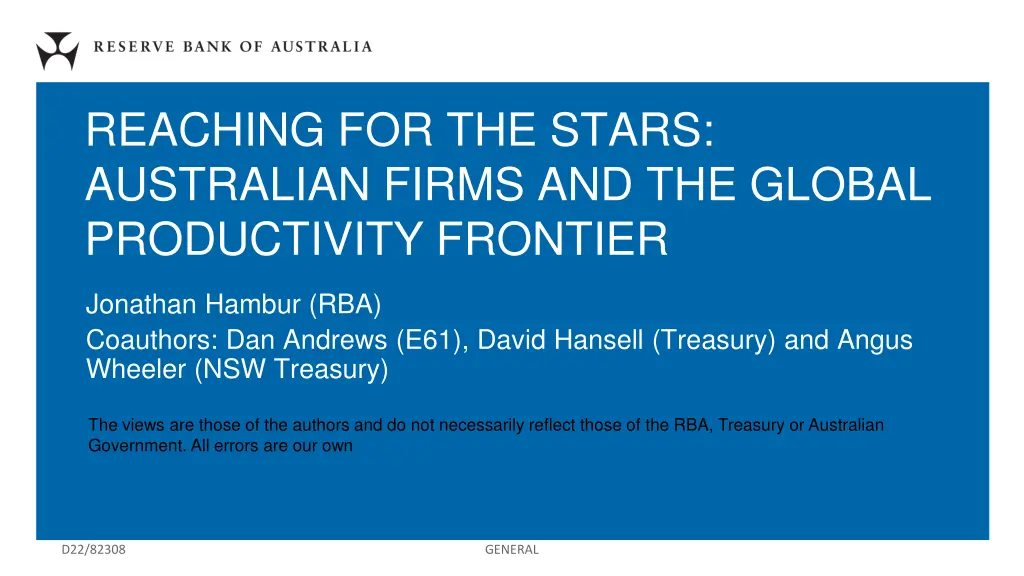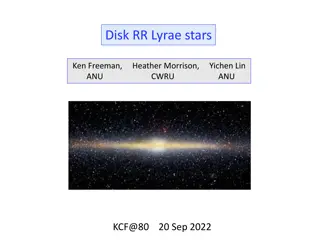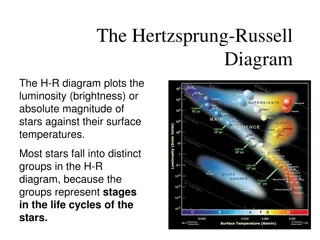
Insights into Australian Firms and Global Productivity Frontier
Explore the factors behind the slowdown in aggregate productivity growth in Australia and other developed economies, including the impact of technological innovation on firm productivity. Learn about key questions, differing views, and the importance of firm-level data in understanding these dynamics.
Download Presentation

Please find below an Image/Link to download the presentation.
The content on the website is provided AS IS for your information and personal use only. It may not be sold, licensed, or shared on other websites without obtaining consent from the author. If you encounter any issues during the download, it is possible that the publisher has removed the file from their server.
You are allowed to download the files provided on this website for personal or commercial use, subject to the condition that they are used lawfully. All files are the property of their respective owners.
The content on the website is provided AS IS for your information and personal use only. It may not be sold, licensed, or shared on other websites without obtaining consent from the author.
E N D
Presentation Transcript
REACHING FOR THE STARS: AUSTRALIAN FIRMS AND THE GLOBAL PRODUCTIVITY FRONTIER Jonathan Hambur (RBA) Coauthors: Dan Andrews (E61), David Hansell (Treasury) and Angus Wheeler (NSW Treasury) The views are those of the authors and do not necessarily reflect those of the RBA, Treasury or Australian Government. All errors are our own D22/82308 GENERAL
Disclaimer The results of these studies are based, in part, on Australian Business Register (ABR) data supplied by the Registrar to the Australian Bureau of Statistics (ABS) under A New Tax System (Australian Business Number) Act 1999 and tax data supplied by the Australian Taxation Office (ATO) to the ABS under the Taxation Administration Act 1953. These require that such data are only used for the purpose of carrying out functions of the ABS. No individual information collected under the Census and Statistics Act 1905 is provided back to the Registrar or ATO for administrative or regulatory purposes. Any discussion of data limitations or weaknesses is in the context of using the data for statistical purposes, and is not related to the ability of the data to support the ABR or ATO's core operational requirements. Legislative requirements to ensure privacy and secrecy of this data have been followed. Only people authorised under the Australian Bureau of Statistics Act 1975 have been allowed to view data about any particular firm in conducting these analyses. In accordance with the Census and Statistics Act 1905, results have been confidentialised to ensure that they are not likely to enable identification of a particular person or organisation.
Why did aggregate productivity growth slow? Productivity is the key determinant of living standards Australia has seen a slowdown in productivity growth since the mid-2000s Broad-based across industries and sectors Understanding the cause is crucial Helps us to develop policies to offset Helps to forecast growth, government revenue
Why did aggregate productivity growth slow? Similar dynamics have been evident across other developed economies In a well-functioning economy 1. Global frontier firms innovate 2. These technologies diffuse to other firms, raising within-firm productivity 3. Reallocation occurs between more and less productive firms
Why did aggregate productivity growth slow? Key question centred on whether this reflected slower technological innovation or other factors: Techno-pessimists (e.g Bob Gordon) vs Techno-optimists (e.g. Erik Brynjolsson) Require firm-level data to examine these mechanisms
A broken diffusion machine? Andrews, Criscuolo & Gal provided key evidence: Continued strong growth at the frontier, but laggards falling further behind Slower diffusion and catch-up driving part of aggregate slowdown Worse in sectors where product market deregulation stalled Labour productivity performance 24 OECD countries Source: Andrews, Criscuolo and Gal (various)
What about Australia? Share of Australian firms that have adopted various technologies Previous work highlighted diffusion of technologies to Australian firms is far from complete Particularly outside of mining Per cent Per cent 80 80 60 60 40 40 20 20 0 0 Data analytics Intelligent software systems Internet of things Radio-frequency Cyber security Management quality score identification devices Energy and metal mining Non-mining Source: Quinn (2019)
What about Australia? Very little evidence direct evidence on technology diffusion, and frontier convergence for Australian firms, until now Our contribution: Compare productivity growth performance of Australian firms to the global frontier Consider whether slower diffusion and convergence to the frontier contributed to the productivity slowdown Consider the role of dynamism and competition
Data Global frontier data: Provided by the OECD Australian data: ABS BLADE database Administrative tax data on the near universe of Australian businesses Focus on the non-resource non-financial private sectors for comparability A little under 50 per cent on the economy Also remove very small firms (less than 3 employees) for comparability
Data Firm-level labour productivity measured as value-added per full-time equivalent employee Compensation to employees plus gross operating surplus Deflated using ANZSIC division level deflators Used to construct average productivity by industry, and for industry leaders (top 5 per cent of firms) and laggards (other firms)
A growing gap to the global frontier Labour productivity performance: Business Sector
A growing gap to the global frontier worse in services Labour productivity performance: Market Services
Econometric analysis Suggestive that slower diffusion may account for part of Australia s productivity slowdown, but not conclusive: Such divergence may be normal Could reflect faster growth at the frontier, rather than slower adoption and convergence No evidence on what s driving the change
Econometric analysis Adopt a neo-Schumpterian framework Firms further from the productivity frontier should have faster productivity growth larger stock of unexploited technologies ln?????= ?0+ ?1ln ?????? 1 + ??,?+ ???+ ???? ??,? control for firm size and age,??? are industry*time effects to account macro cycle and frontier growth Coefficient of interest is ?1. Positive indicates convergence
Productivity convergence Table 1 Baseline model Business Sector Manufacturing Services (1) (2) (3) (4) (5) (6) Distance from frontier 0.423*** 0.443*** 0.468*** 0.489*** 0.409*** 0.429*** (0.002) (0.003) (0.003) (0.006) (0.002) (0.004) Distance from frontier x 2005-07 -0.009** -0.019** -0.006 (0.004) (0.008) (0.005) Distance from frontier x 2008-10 -0.005 -0.015* -0.001 (0.004) (0.008) (0.005) Distance from frontier x 2011-16 -0.039*** -0.031*** -0.041*** (0.004) (0.007) (0.004) Industry-year fixed effects Yes Yes Yes Yes Yes Yes Firm age and size controls Yes Yes Yes Yes Yes Yes R-squared 0.209 0.209 0.230 0.230 0.203 0.203 Observations 1,372,576 1,372,576 331,415 331,415 1,041,161 1,041,161 Notes: Column 1 displays the results for the baseline specification, where the log of firm productivity growth is modelled as a function of the log of distance from the global frontier, with controls for firm age, size and industry-year. Column 2 displays the results for the baseline model with additional dummy variables for the 2005-07, 2008-10, and 2011-14 periods interacted with the distance from frontier term. Columns 3-4 and 5-6 estimate the same specification separately for the manufacturing sector (NACE codes 10-33) and the services sector (NACE codes 45-82, excluding 64-66), respectively. Standard errors are clustered at the firm-level and are shown in brackets underneath each estimate. * significant at 10% level, ** significant at 5% level, *** significant at 1% level.
Productivity convergence has slowed Table 1 Baseline model Business Sector Manufacturing Services (1) (2) (3) (4) (5) (6) Distance from frontier 0.423*** 0.443*** 0.468*** 0.489*** 0.409*** 0.429*** (0.002) (0.003) (0.003) (0.006) (0.002) (0.004) Distance from frontier x 2005-07 -0.009** -0.019** -0.006 (0.004) (0.008) (0.005) Distance from frontier x 2008-10 -0.005 -0.015* -0.001 (0.004) (0.008) (0.005) Distance from frontier x 2011-16 -0.039*** -0.031*** -0.041*** (0.004) (0.007) (0.004) Industry-year fixed effects Yes Yes Yes Yes Yes Yes Firm age and size controls Yes Yes Yes Yes Yes Yes R-squared 0.209 0.209 0.230 0.230 0.203 0.203 Observations 1,372,576 1,372,576 331,415 331,415 1,041,161 1,041,161 Notes: Column 1 displays the results for the baseline specification, where the log of firm productivity growth is modelled as a function of the log of distance from the global frontier, with controls for firm age, size and industry-year. Column 2 displays the results for the baseline model with additional dummy variables for the 2005-07, 2008-10, and 2011-14 periods interacted with the distance from frontier term. Columns 3-4 and 5-6 estimate the same specification separately for the manufacturing sector (NACE codes 10-33) and the services sector (NACE codes 45-82, excluding 64-66), respectively. Standard errors are clustered at the firm-level and are shown in brackets underneath each estimate. * significant at 10% level, ** significant at 5% level, *** significant at 1% level.
Why has convergence slowed? Important to understand why convergence has slowed Overseas evidence has pointed to declining dynamism, firm entry and competition: New firms may find it easier to adopt new tech, or buy old capital from incumbents Entry increases competitive pressure for incumbents Though this can also reduce returns to innovation
Dynamism and competitive pressures have declined Measure of Dynamism Average Mark-up Per cent Per cent 16 16 14 14 Sales-weighted 1.4 1.4 12 12 1.3 1.3 10 10 8 8 Input-weighted* 1.2 1.2 6 6 Unweighted 4 4 1.1 1.1 2 2 0 0 1.0 1.0 Firm entry rate Job switching rate 2004 2005 2006 2007 2008 2009 2010 2011 2012 2013 2014 2015 2016 2017 Early 2000s Recent Source: Andrews and Hansell (2021) Source: Hambur (2020)
Slowdown worse where entry and exit fell Table 2 Turnover, entry and exit model Turnover Entry Exit (1) (2) (3) Distance from frontier 0.418*** 0.415*** 0.423*** (0.011) (0.012) (0.012) Turnover rate x distance from frontier 0.006*** (0.001) Entry rate x distance from frontier 0.009** Convergence 10 per cent faster in high entry industry, than low entry industry (0.003) Exit rate x distance from frontier 0.0146*** (0.00346) Industry-year fixed effects Yes Yes Yes Firm age and size controls Yes Yes Yes R-squared 0.210 0.210 0.210 Observations 1,372,576 1,372,576 1,372,576 Notes: Table 3 extends the baseline model by interacting industry-level firm turnover, entry, and exit rates with the distance from frontier term. The coefficients on the interaction terms estimate the additional convergence speed associated with a 1 percentage point increase in turnover, entry and exit rates. The interpretation of the coefficient on the distance to frontier term is slightly different in Table 2, as the distance to frontier variable and the turnover, entry and exit rates have been demeaned for ease of interpretation. For example, Column 2 implies that an industry with the average firm entry rate has an estimated convergence speed of 0.415. Standard errors are clustered at the industry-level and are shown in brackets underneath each estimate. *significant at 10% level, ** significant at 5% level, *** significant at 1% level.
Slowdown driven by incumbent firms Table 4 Convergence slowdown on separate samples Full Sample Mature Firms Young Firms (1) (2) (3) Distance from frontier 0.443*** 0.432*** 0.463*** (0.003) (0.004) (0.006) Distance from frontier x 2005-07 -0.009** -0.011** 0.000 (0.004) (0.005) (0.007) Distance from frontier x 2008-10 -0.005 -0.010** -0.018** (0.007) (0.004) (0.005) Distance from frontier x 2011-16 -0.039*** -0.047*** -0.001 (0.007) (0.004) (0.005) Industry-year fixed effects Yes Yes Yes Firm age and size controls Yes Yes Yes R-squared 0.209 0.197 0.243 Observations Notes: Table 5 extends the baseline model by interacting the distance from frontier term with dummy variables for the 2005-07, 2008-10, and 2011-14 periods. Column 1 runs this model on the full sample. Column 2 runs the model on a sub-sample of mature firms. Column 3 runs the model on a sub-sample of young firms. The coefficient on the distance from frontier term can now be interpreted as the convergence speed in the base period (2002-04). Standard errors are clustered at the firm-level and are shown in brackets underneath each estimate. *significant at 10% level, ** significant at 5% level, *** significant at 1% level. 1,372,576 996,829 375,747
Slowdown worse where competition declined Table 6 Convergence and industry mark-ups Unweighted mark-ups Sales-weighted mark-ups (1) (2) Distance from frontier 0.349*** 0.390*** (0.039) (0.003) Industry level markup x distance from frontier -0.116*** -0.310*** (0.019) (0.057) Yes Industry-year fixed effects Yes Firm age and size controls Yes Yes R-squared 0.212 0.212 1,270,768 Observations 1,270,768 Notes: Table 5 extends the baseline model by interacting industry-level mark-ups with the distance from frontier term. Column 1 runs this model for unweighted averages of the firm mark-ups. Column 2 runs this model for sales-weighted averages of the firm mark-ups. The mark-up variables are demeaned for ease of interpretation. The coefficient on the distance from frontier term can now be interpreted as the convergence speed for firms in an industry with the average markup. The interaction term can be interpreted as the additional convergence speed associated with a 1 percentage point increase in the firm entry rate. Standard errors are clustered at the industry-level and are shown in brackets underneath each estimate. *significant at 10% level, ** significant at 5% level, *** significant at 1% level.
Why has convergence slowed? Results suggest that declining dynamism and competitive pressures lessened incentives to adopt and improve Decline in convergence rate How much if the slowdown in convergence does this explain? 4ppt, or 9 per cent decline in convergence, much of which reflect dynamism
Added to dynamisms role in slower resource reallocation and market selection Gap in growth between high and low productivity firms Since mid 2000s, less productive firms more likely to survive and labour flowed more slowly to productive firms Percentage points Percentage points 2003 2009 2016 10 10 8 8 Explains of productivity slowdown 6 6 4 4 Issue worse where in industries where mark-ups have risen (Andrews and Hansell 2021; Hambur 2020) 2 2 0 0 All Firms Old Firms Young Firms A: Employment growth gap B: Exit probability gap (low vs high productivity firm) Source: Andrews and Hansell (2021)
Implications Points to importance of policies aimed at decreasing barriers to dynamism and competitive pressures: Address potential barriers to firm entry and growth (regulations, financing constraints) Ensuring workers have the skills to employ new technology More work needed to understand exact barriers: Joint Tsy RBA work on technology diffusion






















